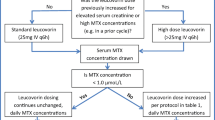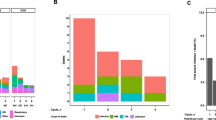Abstract
Objective
The aims of our study were to determine the factors associated with developing haematological toxicity (HT) in patients taking linezolid (LZD), to develop a predictive model of HT in these patients, and to evaluate factors associated with 30-day mortality.
Methods
This was an observational retrospective cohort study of patients treated for at least 5 days with LDZ in 2015. Demographic, clinical and analytical data were collected. Development of HT was defined as a 25% platelet count decrease between the basal count and the 1-week lab test.
Results
Five hundred forty-nine patients were finally included, mean age was 73.3 (SD 15.4) years, and 303 (55.2%) were men. One hundred seventy-five (30.1%) patients achieved HT criteria during treatment with LZD and 41 (7.5%) died. The final model included the presence of cerebrovascular disease (2 points), moderate or severe liver disease (2 points), renal failure (2 points) and basal platelet count less than 90,000/mm3 (8 points). This new model showed an AUC of 0.711 (IC 95% 0.664–0.757; p < 0.001) to predict the development of HT. The probability of HT based on this classification was 6.2, 29.9 and 76.5% for low (0–4 points), intermediate (5–10 points) and high risk (>10 points), respectively. The independent variables associated with 30-day mortality were metastatic solid tumor, lymphoma, age >75 years and HT.
Conclusion
This score could help in the identification of patients with high risk for HT and assess the use of an antibiotic other than LZD, an important issue considering its relation with 30-day mortality observed in our study.


Similar content being viewed by others
References
Zhao M, Liang L, Ji L, Chen D, Zhang Y, Zhu Y, Patel K (2016) Similar efficacy and safety of daptomycin versus linezolid for treatment of vancomycin-resistant enterococcal bloodstream infections: a meta-analysis. Int J Antimicrob Agents 48:231–238
Diekema DI, Jones RN (2000) Oxazolidinones: a review. Drugs 59:7–16
Attassi K, Hershberger E, Alam R, Zervos MJ (2002) Thrombocytopenia associated with linezolid therapy. Clin Infect Dis 34:695–698
Kuter DJ, Tillotson GS (2001) Hematologic effects of antimicrobials: focus on the oxazolidinone linezolid. Pharmacotherapy 21:1010–1013
Dong HY, Xie J, Chen LH (2014) Therapeutic drug monitoring and receiver operating characteristic curve prediction may reduce the development of linezolid-associated thrombocytopenia in critically ill patients. Eur J Clin Microbiol Infect Dis 33:1029–35
Chen C, Guo DH, Cao X (2012) Risk factors for thrombocytopenia in adult Chinese patients receiving linezolid therapy. Curr Ther Res Clin Exp 73:195–206
Hirano R, Sakamoto Y, Tachibana N (2014) Retrospective analysis of the risk factors for linezolid-induced thrombocytopenia in adult Japanese patients. Int J Clin Pharm 36:795–9
Natsumoto B, Yokota K, Omata F, Furukawa K (2014) Risk factors for linezolid-associated thrombocytopenia in adult patients. Infection 42:1007–1012
Bi LQ, Zhou J, Huang M, Zhou SM (2013) Efficacy of linezolid on gram-positive bacterial infection in elderly patients and the risk factors associated with thrombocytopenia. Pak J Med Sci 29:837–842
Moraza L, Leache L, Aquerreta I, Ortega A (2015) Linezolid-induced haematological toxicity. Farm Hosp 39:320–326
Soriano A, Ortega M, Garcia S, Penarroja G, Bove A, Marcos M et al (2007) Comparative study of the effects of pyridoxine, rifampin, and renal function on hematological adverse events induced by linezolid. Antimicrob Agents Chemother 51:2559–2563
Tomás Vecina S, Mozota Duarte J, Ortega Marcos M, Ruiz Navarro MG, Borillo V, San Juan GL et al (2016) Peripheral venous catheter use in the emergency department: reducing adverse events in patients and biosafety problems for staff. Emergencias 28:89–96
Tejedor Fernández M, Ferrer Higueras MJ, Tejedor BR (2016) Patient safety, clinical outcomes, and efficiency in the emergency department. Emergencias 28:141–2
Monclús Cols E, Capdevila Reniu A, Roedberg Ramos D, Pujol Fontrodona G, Ortega RM (2016) Management of severe sepsis and septic shock in a tertiary care urban hospital emergency department: opportunities for improvement. Emergencias 28:229–34
Oltean S, Tatulescu D, Bondor C, Slavcovici A, Cismaru C, Lupse M et al (2012) Charlson’s weighted index of comorbidities is useful in assessing the risk of death in septic patients. J Crit Care 27:370–375
U.S. Department of Health and Human Services (2010) Common terminology criteria for adverse events (CTCAE), version 4.0. 2009 (v4.03: June 14, 2010). National Institutes of Health. National Cancer Institute. Available at: http://evs.nci.nih.gov/ftp1/CTCAE/CT-CAE_4.03_2010-06-14_QuickReference_5x7.pdf
Gómez-Alonso B, Rodríguez-Álvarez C, Castro Hernández B, Arias Rodríguez A, Aguirre-Jaime A, Lecuona FM (2016) Hospital emergency health service care as a risk factor for methicillin-resistant Staphylococcus aureus in residents of long-term care facilities. Emergencias 28:381–6
Shorr AF, Lodise TP, Corey GR, De Anda C, Fang E, Das AF et al (2015) Analysis of the phase 3 ESTABLISH trials of tedizolid versus linezolid in acute bacterial skin and skin structure infections. Antimicrob Agents Chemother 59:864–71
Friedland HD, O’Neal T, Biek D, Eckburg PB, Rank DR, Llorens L et al (2012) CANVAS 1 and 2: analysis of clinical response at day 3 in two phase 3 trials of ceftaroline fosamil versus vancomycin plus aztreonam in treatment of acute bacterial skin and skin structure infections. Antimicrob Agents Chemother 56:2231–6
Dunne MW, Puttagunta S, Giordano P, Krievins D, Zelasky M, Baldassarre J (2016) A randomized clinical trial of single-dose versus weekly dalbavancin for treatment of acute bacterial skin and skin structure infection. Clin Infect Dis 62:545–51
Ikuta S, Tanimura K, Yasui C, Aihara T, Yoshie H, Iida H et al (2011) Chronic liver disease increases the risk of linezolid-related thrombocytopenia in methicillin-resistant Staphylococcus aureus-infected patients after digestive surgery. J Infect Chemother 17:388–91
Matsumoto K, Takeda Y, Takeshita A et al (2009) Renal function as a predictor of linezolid-induced thrombocytopenia. Int J Antimicrob Agents 33:98–9
Nukui Y, Hatakeyama S, Okamoto K et al (2013) High plasma linezolid concentration and impaired renal function affect development of linezolid-induced thrombocytopenia. J Antimicrob Chemother 68:2128–33
Sasaki T, Takane H, Ogawa K, Isagawa S, Hirota T, Higuchi S et al (2011) Population pharmacokinetic and pharmacodynamic analysis of linezolid and a hematologic side effect, thrombocytopenia, in Japanese patients. Antimicrob Agents Chemother 55:1867–73
Afdhal N, McHutchison J, Brown R, Jacobson I, Manns M, Poordad F et al (2008) Thrombocytopenia associated with chronic liver disease. J Hepatol 48:1000–7
Milanowski L, Pordzik J, Janicki PK, Postula M (2016) Common genetic variants in platelet surface receptors and its association with ischemic stroke. Pharmacogenomics 17:953–71
Keshet R, Boursi B, Maoz R, Shnell M, Guzner-Gur H (2009) Diagnostic and prognostic significance of serum C-reactive protein levels in patients admitted to the department of medicine. Am J Med Sci 337:248–55
Martín-Sánchez FJ, González Del Castillo J (2015) Sepsis en el anciano: ¿están preparados los servicios de urgencias hospitalarios? Emergencias 27:73–4
Acknowledgments
The authors wish to thank Juan González Núñez and Ana González Núñez for helping us with English text correction.
Author information
Authors and Affiliations
Consortia
Corresponding author
Ethics declarations
Funding
The study was not funded.
Conflict of interest
The authors declare that they have no conflict of interest.
Ethical approval
The Ethical Committee of the Clínico San Carlos Hospital approved the study.
Informed consent
Considering the characteristics of the study (observational retrospective cohort study), the ethical committee allowed us the exemption of obtaining informed consent.
Addendum
Addendum
Representatives of the Emergency Department Investigation Unit
Fahd Beddar Chaib (Emergency Department)
Flavia Chirella (Clinical Microbiology Department)
Sol Hernández (Emergency Department)
Iván Larrosa-Espejo (Pharmacy Department)
Laura Lopez-González (Clinical Microbiology Department)
Marta Gonzalvo Navarro (Emergency Department)
Maria Isabel Perea Casado (Emergency Department)
Alberto Pérez-Morales (Pharmacy Department)
David Redondo-Domínguez (Emergency Department)
Víctor Rodríguez-Neira (Emergency Department)
José Carlos Tallón-Martínez (Pharmacy Department)
May Trujillo-Fox (Emergency Department)
Rights and permissions
About this article
Cite this article
González-Del Castillo, J., Candel, F.J., Manzano-Lorenzo, R. et al. Predictive score of haematological toxicity in patients treated with linezolid. Eur J Clin Microbiol Infect Dis 36, 1511–1517 (2017). https://doi.org/10.1007/s10096-017-2960-5
Received:
Accepted:
Published:
Issue Date:
DOI: https://doi.org/10.1007/s10096-017-2960-5




